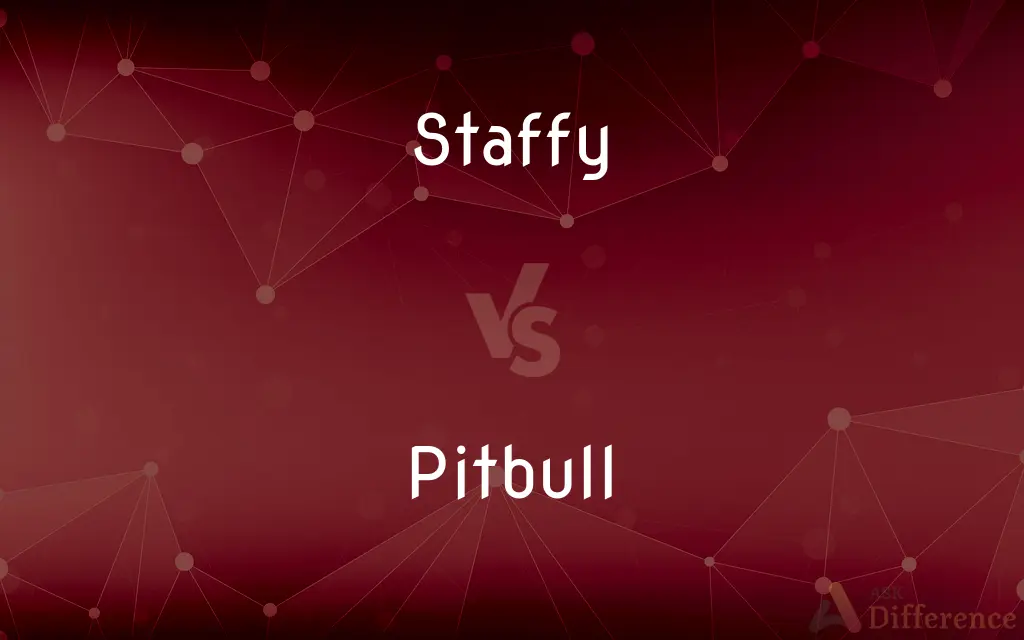Staffy vs. Pitbull — What's the Difference?
By Urooj Arif & Maham Liaqat — Published on March 9, 2024
Staffies (Staffordshire Bull Terriers) are known for their muscular build, loyalty, and affectionate nature towards families. Pitbulls, a broader category including several breeds, are characterized by their strength, courage, and determination.

Difference Between Staffy and Pitbull
Table of Contents
ADVERTISEMENT
Key Differences
Staffies, or Staffordshire Bull Terriers, originated in the UK and were bred for bull-baiting and later as companion dogs. They are recognized for their robust, muscular physique, standing around 14 to 16 inches tall at the shoulder. In contrast, the term "Pitbull" generally refers to a group of breeds including the American Pit Bull Terrier, American Staffordshire Terrier, and others. These breeds were originally used in blood sports such as bull-baiting and later as farm dogs.
While both Staffies and Pitbulls can make devoted and loving pets with proper training and socialization, they have distinct temperamental traits. Staffies tend to be more openly affectionate with family members and are known for their love of being close to their humans. Pitbulls, while also affectionate towards their families, may have a higher energy level and a stronger prey drive, requiring more rigorous exercise and mental stimulation.
In terms of appearance, Staffies usually have a shorter coat, a broader head, and a more pronounced cheek muscle than Pitbulls. Their build is stocky and muscular, but they are smaller in stature compared to most Pitbull breeds. On the other hand, Pitbulls have a more varied appearance due to the different breeds under the Pitbull umbrella but generally feature a muscular build, a short coat, and a powerful jaw.
Legislation regarding ownership varies significantly between the two, with Staffies facing fewer breed-specific laws compared to Pitbulls. Many regions have enacted breed-specific legislation (BSL) that restricts or outright bans the ownership of Pitbull-type dogs due to perceived aggression risks. However, it's important to note that behavior in individual dogs is greatly influenced by training, socialization, and the environment provided by their owners.
Both Staffies and Pitbulls have faced challenges related to public perception. Efforts by breed enthusiasts and animal welfare organizations aim to highlight their capacity for companionship, loyalty, and suitability as family pets, advocating against breed discrimination and for responsible ownership.
ADVERTISEMENT
Comparison Chart
Origin
United Kingdom
United States and United Kingdom
Size
14-16 inches at the shoulder, stockier build
17-21 inches at the shoulder, more varied sizes
Temperament
Loyal, affectionate, particularly good with children
Courageous, strong-willed, energetic
Activity Level
Moderate, enjoys being close to family
High, requires vigorous exercise and mental stimulation
Appearance
Short coat, broad head, pronounced cheek muscles
Muscular build, short coat, powerful jaw, more varied appearance
Legislation
Fewer breed-specific laws
Often subject to breed-specific legislation
Suitability as Pets
Excellent with proper training and socialization
Excellent with proper training, socialization, and exercise
Public Perception
Controversial due to breed confusion, but improving
More controversial, often misunderstood
Ideal Environment
Adaptable to various living situations, requires close human interaction
Needs space for exercise, benefits from structured activities
Breed-Specific Issues
Prone to certain hereditary conditions, misunderstood aggression
Often targeted by breed-specific legislation, perceived aggression
Compare with Definitions
Staffy
Prized for their loyalty and protective nature.
A Staffy might become very protective of the children in the household.
Pitbull
Encompasses several breeds, known for strength and determination.
American Pit Bull Terriers excel in agility sports due to their athleticism.
Staffy
Recognized by their broad head and short stature.
Despite their small size, Staffies display a strong and muscular build.
Pitbull
Exhibits a wide range of sizes and appearances.
Pitbulls can vary greatly in color and size, reflecting the diversity within the category.
Staffy
A muscular and affectionate breed, great with families.
Staffies are known to form strong bonds with all family members.
Pitbull
Requires active engagement and exercise.
A Pitbull may need several hours of exercise and mental stimulation daily.
Staffy
Adaptable to living conditions, thriving on human companionship.
Staffies can live happily in apartments as long as they have regular interaction and exercise.
Pitbull
Often misunderstood and subject to breed bans.
Despite their loyal nature, Pitbulls are banned in certain areas.
Staffy
Faces fewer legal restrictions than Pitbulls.
Staffies are generally welcomed in communities with breed-specific legislation.
Pitbull
Valued for their courage and loyalty.
Pitbulls are often used in search and rescue operations due to their bravery and loyalty.
Pitbull
An aggressive person.
My mother was a pitbull.
Pitbull
NATO brevity code indicating a semi-active radar homing missile has begun active homing, and no longer requires its operator to maintain a radar track.
Common Curiosities
What is the main difference between Staffies and Pitbulls?
The main difference lies in their origin, size, and breed-specific traits, with Staffies being smaller and originating from the UK, and Pitbulls representing a broader category with more varied appearances and originating primarily from the US.
Can Staffies and Pitbulls be good family pets?
Yes, both can be excellent family pets with proper training, socialization, and care, known for their loyalty and affection towards their owners.
Why are Pitbulls more controversial than Staffies?
Pitbulls are often more controversial due to broader public misconceptions, a higher profile in media reports of dog attacks, and the resulting breed-specific legislation.
Do Staffies and Pitbulls have similar health issues?
Both breeds can be prone to certain hereditary health issues, but responsible breeding practices can reduce these risks. It's important for potential owners to research and choose reputable breeders.
How do the exercise needs of Staffies compare to those of Pitbulls?
Pitbulls typically require more vigorous exercise and mental stimulation due to their high energy levels, whereas Staffies have moderate exercise needs but also thrive on close human interaction.
Are Staffies subject to the same breed-specific legislation as Pitbulls?
Staffies generally face fewer restrictions than Pitbulls, although this can vary by location and specific legislation.
Is it easy to distinguish between a Staffy and a Pitbull?
While there are physical differences, such as size and head shape, non-experts may find it challenging to distinguish between the two, especially given the variety within the Pitbull category.
How do Staffies and Pitbulls behave around other dogs?
Individual behavior can vary widely; however, both breeds may exhibit strong prey drives and should be socialized from an early age. Staffies are generally known for being more sociable with humans than other dogs.
What should potential owners consider before getting a Staffy or Pitbull?
Potential owners should consider their ability to provide adequate exercise, socialization, and training, as well as checking local legislation and insurance policies regarding breed ownership.
What can be done to improve the public image of Staffies and Pitbulls?
Education, responsible ownership, and positive media representation can help improve the public image of these breeds, highlighting their affectionate nature and suitability as family pets.
Share Your Discovery

Previous Comparison
Usted vs. Ustedes
Next Comparison
Tapioca Pudding vs. Rice PuddingAuthor Spotlight
Written by
Urooj ArifUrooj is a skilled content writer at Ask Difference, known for her exceptional ability to simplify complex topics into engaging and informative content. With a passion for research and a flair for clear, concise writing, she consistently delivers articles that resonate with our diverse audience.
Co-written by
Maham Liaqat















































